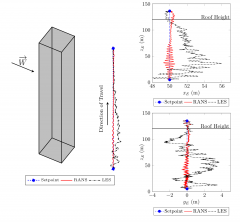Due to the inherent difficulties with flight testing, simulation tools can provide valuable proving grounds. Small, and thus light, uninhabited vehicles flying within the confines of urban environments can often find the associated wind patterns generated by urban structures challenging to navigate. Therefore, a database of common urban structures and their associated wakes has been developed which can be used to generate wakefields for various windspeeds and angles.

Using both Reynolds Averaged Navier-Stokes Simulations (RANS) and Large Eddy Simulations (LES), these wakefields are used to evaluate their effect on the autonomous flight of a small quadcopter. Results using both RANS and LES for a quadcopter hovering within the wake of a building can vary by as much as two orders of magnitude.

Indeed, while hovering within a building wake a RANS simulation will predict position variations on the order of plus/minus 1 body length compared to +12/-4 body lengths if the building wake is represented by an LES simulation.
